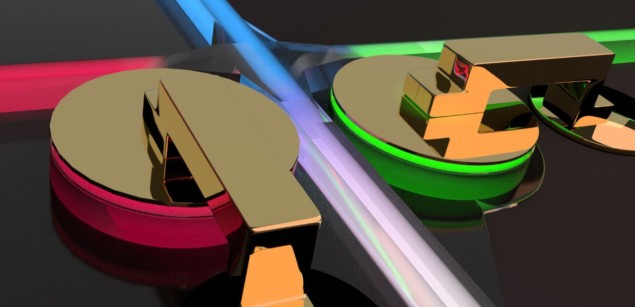
A highly compact, low-energy device capable of switching the paths taken by light within photonic systems has been unveiled by physicists in the US and Switzerland. The new switch could provide a basis for artificial-intelligence (AI) systems that mimic human decisions, allowing for a diverse range of applications.
“All-optical computers” use light instead of electronic signals to process information. In principle, they could be faster and much more energy efficient than conventional computers. However, it is proving very difficult to create compact and energy efficient photonic devices that can switch and process optical signals at high speeds.
The new device was created by Chris Haffner and colleagues at the National Institute of Standards and Technology (NIST), ETH Zurich and the University of Maryland.
Light enters the switch via a linear silicon waveguide that is adjacent to a racetrack-shaped cavity that is etched onto a silicon disc. If the wavelength of the incoming light resonates with the racetrack cavity, some of the light will enter the racetrack and circulate around it many times.
Gold membrane
The device also incorporates an extremely thin, circular gold membrane, suspended just a few nanometres above the disc. This membrane is connected to the disc by doped silicon and gold bridges, enabling Haffner and colleagues to apply a varying voltage between the two structures. This allows them to bend the membrane either up or down, creating a variable gap between it and the waveguide.
As some of the light travelling around the cavity escapes, it strikes the membrane, creating collective oscillations of electrons (called plasmons) on the gold’s surface. These plasmons vibrate at the same frequency as the light, but with much shorter wavelengths. This means that the plasmons can be converted back into light with a high degree of control.

The promise of silicon photonics
When the membrane is bent upwards, the rest of the light in the waveguide passes through unaffected. When positioned downwards, however, the membrane plasmons oscillations allow light to leak from the waveguide into the cavity. This light can then interfere destructively with light in the waveguide, essentially turning off the transmission of light. Furthermore, light can be transferred to a second waveguide positioned close to the membrane – rerouting the path of the light.
The compactness and low energy requirements of the device allowed the team to integrate it onto a single computer chip. They envisage a wealth of AI-related applications for their device, including self-driving cars which can rapidly redirect light beams to scan for other cars and pedestrians. More generally, the technology could bring about advanced circuits that form the backbones of neural networks – capable of recognizing patterns and making human-like decisions about complex tasks.
The new switch is described in Science.



